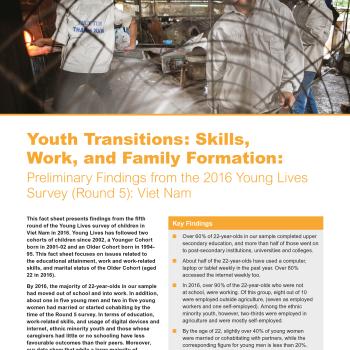Publication Information

Round 5 Longitudinal Youth Transitions: Skills Work and Family Formation Fact Sheet
This fact sheet presents findings from the fifth round of the Young Lives survey of children in Viet Nam in 2016. Young Lives has followed two cohorts of children since 2002, a Younger Cohort born in 2001-02 and an Older Cohort born in 1994-95. This fact sheet focuses on issues related to the educational attainment, work and work-related skills, and marital status of the Older Cohort (aged 22 in 2016). By 2016, the majority of 22-year-olds in our sample had moved out of school and into work. In addition, about one in five young men and two in five young women had married or started cohabiting by the time of the Round 5 survey. In terms of education, work-related skills, and usage of digital devices and internet, ethnic minority youth and those whose caregivers had little or no schooling have less favourable outcomes than their peers. Moreover, our data show that while a large majority of 22-year-olds in our sample were employed outside agriculture, ethnic minority young people are most likely to be self-employed in the agricultural sector.
Key Findings:
Over 60% of 22-year-olds in our sample completed upper secondary education, and more than half of those went on to post-secondary institutions, universities and colleges.
About half of the 22-year-olds have used a computer, laptop or tablet weekly in the past year. Over 80% accessed the internet weekly too.
In 2016, over 90% of the 22-year-olds who were not at school, were working. Of this group, eight out of 10 were employed outside agriculture, (seven as employed workers and one self-employed). Among the ethnic minority youth, however, two-thirds were employed in agriculture and were mostly self-employed.
By the age of 22, slightly over 40% of young women were married or cohabitating with partners, while the corresponding figure for young men is less than 20%.
In 2016, nearly 75% of 22-year-olds were exclusively working, as few as 6% were exclusively studying, slightly under 10% were combining both activities, and 10% were in neither work or education.

Round 5 Longitudinal Youth Transitions: Skills Work and Family Formation Fact Sheet
This fact sheet presents findings from the fifth round of the Young Lives survey of children in Viet Nam in 2016. Young Lives has followed two cohorts of children since 2002, a Younger Cohort born in 2001-02 and an Older Cohort born in 1994-95. This fact sheet focuses on issues related to the educational attainment, work and work-related skills, and marital status of the Older Cohort (aged 22 in 2016). By 2016, the majority of 22-year-olds in our sample had moved out of school and into work. In addition, about one in five young men and two in five young women had married or started cohabiting by the time of the Round 5 survey. In terms of education, work-related skills, and usage of digital devices and internet, ethnic minority youth and those whose caregivers had little or no schooling have less favourable outcomes than their peers. Moreover, our data show that while a large majority of 22-year-olds in our sample were employed outside agriculture, ethnic minority young people are most likely to be self-employed in the agricultural sector.
Key Findings:
Over 60% of 22-year-olds in our sample completed upper secondary education, and more than half of those went on to post-secondary institutions, universities and colleges.
About half of the 22-year-olds have used a computer, laptop or tablet weekly in the past year. Over 80% accessed the internet weekly too.
In 2016, over 90% of the 22-year-olds who were not at school, were working. Of this group, eight out of 10 were employed outside agriculture, (seven as employed workers and one self-employed). Among the ethnic minority youth, however, two-thirds were employed in agriculture and were mostly self-employed.
By the age of 22, slightly over 40% of young women were married or cohabitating with partners, while the corresponding figure for young men is less than 20%.
In 2016, nearly 75% of 22-year-olds were exclusively working, as few as 6% were exclusively studying, slightly under 10% were combining both activities, and 10% were in neither work or education.

